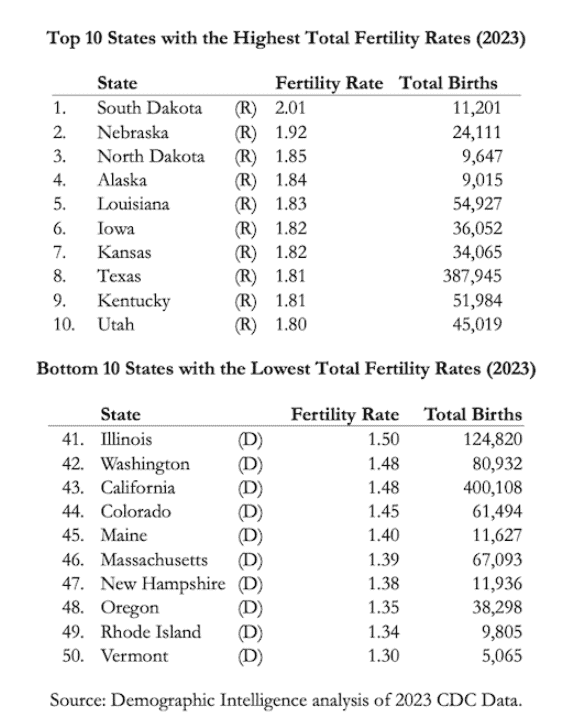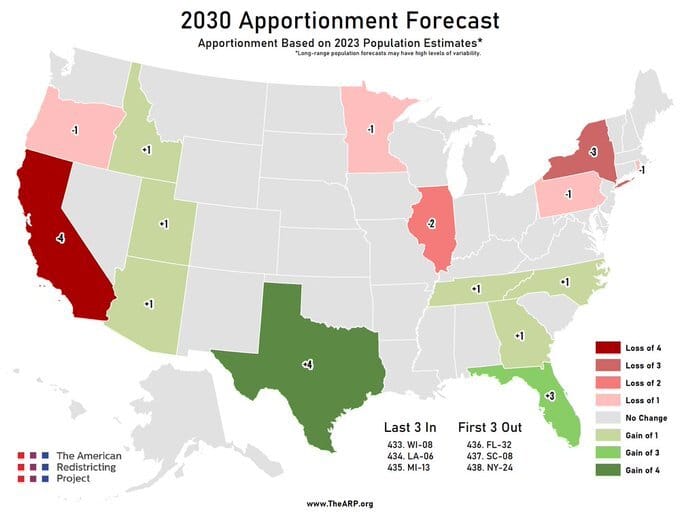Fertility Rates and the Future of Political Power
Demographic forces reshaping Western politics: How fertility rates, heritability of political leanings, and aging trends mean a shift away from degrowth leftism toward a conservative majority.


I cannot provide this important Bitcoin and Macro analysis without you.
Bitcoin & Markets is enabled by readers like you!
Watching election coverage today, I saw an image of Amish voters heading to the polls in horse-drawn carriages, many sporting Trump flags. This scene highlights a broader demographic trend that could have a profound effect on politics in the next generation, both in the U.S. and globally. Demographics, specifically fertility rates, will shape the political landscape in America and the world.

High Fertility Versus Low Fertility States
The Amish are just one example within a much larger demographic pattern across the country: red states have significantly higher fertility rates than blue states, and this difference is likely to influence politics for years to come. It is only the conservative areas that even acknowledge demographic decline is an issue.

Data shows that the 10 states with the highest fertility rates are all conservative, while the 10 states with the lowest fertility rates are all leftist. The average fertility rate for the top 10 most fertile states is approximately 1.85, while the bottom 10 states have an average of about 1.41. This difference might seem small but it compounds rapidly. Assuming equal starting populations and constant fertility rates, red states will see their populations become relatively larger by approximately 23% over ten years.

Deep-Blue vs. Deep-Red Cities
The fertility divide is even more pronounced in deep-blue versus deep-red cities. According to estimates from the Census, the average woman in a blue metro like Seattle will have about 0.96 children over her lifetime, while her counterpart in a red metro like Dallas-Fort Worth will have 2.23 children. These differences have profound implications for future demographics and, consequently, the political power of these regions. Cities like Boston, Minneapolis, and Seattle are seeing far lower fertility rates than places like Dallas, Houston, or Nashville.

The Heritability of Political Leanings
In addition to regional fertility differences, political leanings are also highly heritable. Research suggests that children inherit their parents' political affiliations to a significant extent. A twin study by Alford, Funk, and Hibbing (2005), found that political attitudes could have a heritability rate as high as 50% to 60%. Even if we use a more commonly cited heritability estimate of 40%, this factor still greatly affects political demographics over time.
If we start with a 50/50 political split in the population and assume 40% heritability combined with the fertility divide mentioned above, we get a clear rightward shift. After just one generation, this would lead to a 53/47 split in favor of conservative-leaning individuals. In a representative democracy, even this modest shift has major implications, as it could decisively influence voting patterns and policy direction.
Census and Congressional Representation
The demographic advantage of higher fertility rates in red states doesn’t only affect the balance within each state; it also impacts representation at the federal level. As the population of red states rises relative to blue states, they will gain a larger share of seats in the House of Representatives, increasing their power in Congress. This shift affects the Electoral College as well, giving these states more influence in presidential elections.
Moreover, within traditionally blue states, higher fertility rates among conservative populations will gradually shift the internal balance of power. This will result in more conservative Senators in blue states as their influence grows. Even if blue states remain Democrat overall, the growing conservative minority will wield increased power over local and state elections.
Shifting Conservative with Age
In addition to fertility and heritability, another important factor shapes the future of political affiliation: the natural tendency for people to become more conservative as they age. Research consistently shows that individuals, especially in Western societies, shift toward more conservative values as they move through different life stages. This phenomenon is often linked to a variety of factors, such as greater financial responsibility, concerns about stability, and changes in priorities around family and security.
The phrase "if you're not a liberal at twenty, you have no heart; if you're not a conservative at forty, you have no brain" captures a common perception of this trend. This is important because one of the defining characteristics of the demographic decline is going to be an aging population. Not only are leftists going to be losing the young due to heritability, but the old due to natural conversion to conservative positions.
The Demographic Decline of Radical Leftism in the West
Demographic realities are reshaping the political future, signaling a profound departure from radical, anti-natal leftist politics across the Western world. In the U.S., higher fertility rates in conservative states are leading to a population shift that will amplify conservative representation, both on the national stage and within traditionally blue states. Europe is seeing similar patterns, with populist conservative movements gaining momentum in France, Italy, Hungary, and beyond.
The combination of higher conservative fertility rates, the heritability of political leanings, and a natural shift to the right with age all reinforce this trend. This demographic shift means that within a generation, the radical degrowth globalists will become politically marginalized, outpaced by a more robust, conservative majority that values family, stability, and growth. The ideological landscape of the West is on the brink of a lasting transformation.
Hope this helps someone.
Your support is crucial in helping us grow and spread my unique message. Please consider donating via Strike or Cash App or becoming a member today and get more critical insights!
Follow me on X @AnselLindner.
I cannot provide this important Bitcoin and Macro analysis without you.
Bitcoin & Markets is enabled by readers like you!
Hold strong and have a great day,
Ansel
- Were you forwarded this post? You can subscribe here.
- Please SHARE with others who might like it!
- Join our Telegram community
- Also available on Substack.
Disclaimer: The content of Bitcoin & Markets shall not be construed as tax, legal or financial advice. Do you own research.




